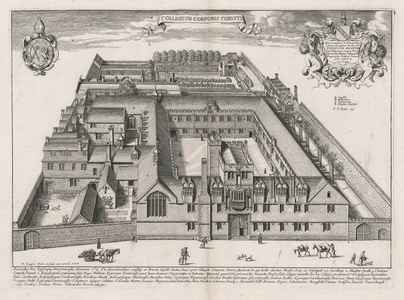| Method | Copper engraving |
| Artist | David Loggan |
| Published | [Oxford, 1675] |
| Dimensions | Image 267 x 393 mm, Plate 293 x 398 mm, Sheet 360 x 460 mm |
| Notes |
A view of Corpus Christi College, from the first edition of 'Oxonia Illustrata' published in 1675. David Loggan (1635-1692), artist and engraver, was born at Danzig in 1635. He may have learnt the art of engraving from Simon van den Passe in Denmark and from Hendrik Hondius in the Netherlands. Loggan followed Hondius's sons to England in about 1653 and by 1665 he was residing at Nuffield, near Oxford, and had made the acquaintance of Anthony Wood. Some years later Loggan produced his Oxonia Illustrata, which was intedned as a companion work to Wood's Historia Antiquitates Universitatis Oxoniensis. On 30 March 1669 Loggan was appointed Engraver to the University of Oxford, with an annual salary of twenty shillings. He married a daughter of Robert Jordan, Esq., of Kencote Hall in Oxfordshire, in 1671 and they had a son; John Loggan, who later graduated from Trinity College, the following year. The marriage probably produced another son, William Loggan, about whom little is known except that he was responsible for a satirical print of Father Peters and the Jesuits, published in 1681. David Loggan took up residence in Holywell in about 1671, prior to matriculating at the University. In 1675 he was naturalised as an Englishman. Loggan's 'great work' is the earliest and best collection of Oxford views and his much rarer Cambridge engravings. The extraordinary amount of accurate detail in both implies considerable time spent on the study of the buildings and on the preparation of the plates. The Oxford views, as the Introduction tells us, had been 'long expected, and begun several years before' [diu expectatum Opus, annis abhinc aliquot susceptum']. Wood refers to the plates as early as 1665, which is the date that Loggan lived at Nuffield in Oxfordshire, and the probable date that he started work on the views. He mentions them again in 1669, when Loggan was able to exhibit many of the plates as finished. Wood clearly expected that the sheets would have been ready in 1674 to be bound with his Historia et Antiquitates, by those that wished it. He both disclaimed responsibility for the captions to the plates in his introduction to the reader, and several times elsewhere referred to them as 'the cuts belonging to my book'. This, and the fact that Loggan's Index refers to Wood, relating the illustration to the place where a history of the building can be found, provides clear evidence of an intention that Wood's history and Loggan's views should appear together. Why they didn't is unclear, because it seems that they were ready. Fell had written, on Jan. 19th, 1674/5, that the plates were 'in a manner quite finished'. It may be that the tensions which had arisen between Fell and Wood over the editing of Historia et Antiquitates hold the key to this puzzle. The plates were not printed at the Sheldonian, but at Leonard Lichfield's house in Holywell, where it is presumed that the rolling press was housed. Condition: Good clean impression. Pressed vertical centrefold as issued. Repaired split to base of centre fold not affecting plate or image. |
| Framing | unmounted |
| Price | £625.00 |
| Stock ID | 52838 |

